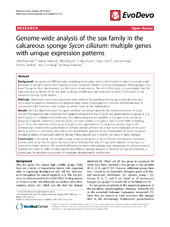| dc.description.abstract | Background: Sox genes are HMG-domain containing transcription factors with important roles in developmental processes in animals; many of them appear to have conserved functions among eumetazoans. Demosponges have fewer Sox genes than eumetazoans, but their roles remain unclear. The aim of this study is to gain insight into the early evolutionary history of the Sox gene family by identification and expression analysis of Sox genes in the calcareous sponge Sycon ciliatum. Methods: Calcaronean Sox related sequences were retrieved by searching recently generated genomic and transcriptome sequence resources and analyzed using variety of phylogenetic methods and identification of conserved motifs. Expression was studied by whole mount in situ hybridization. Results: We have identified seven Sox genes and four Sox-related genes in the complete genome of Sycon ciliatum. Phylogenetic and conserved motif analyses showed that five of Sycon Sox genes represent groups B, C, E, and F present in cnidarians and bilaterians. Two additional genes are classified as Sox genes but cannot be assigned to specific subfamilies, and four genes are more similar to Sox genes than to other HMG-containing genes. Thus, the repertoire of Sox genes is larger in this representative of calcareous sponges than in the demosponge Amphimedon queenslandica. It remains unclear whether this is due to the expansion of the gene family in Sycon or a secondary reduction in the Amphimedon genome. In situ hybridization of Sycon Sox genes revealed a variety of expression patterns during embryogenesis and in specific cell types of adult sponges. Conclusions: In this study, we describe a large family of Sox genes in Sycon ciliatum with dynamic expression patterns, indicating that Sox genes are regulators in development and cell type determination in sponges, as observed in higher animals. The revealed differences between demosponge and calcisponge Sox genes repertoire highlight the need to utilize models representing different sponge lineages to describe sponge development, a prerequisite for deciphering evolution of metazoan developmental mechanisms. | en_US |




